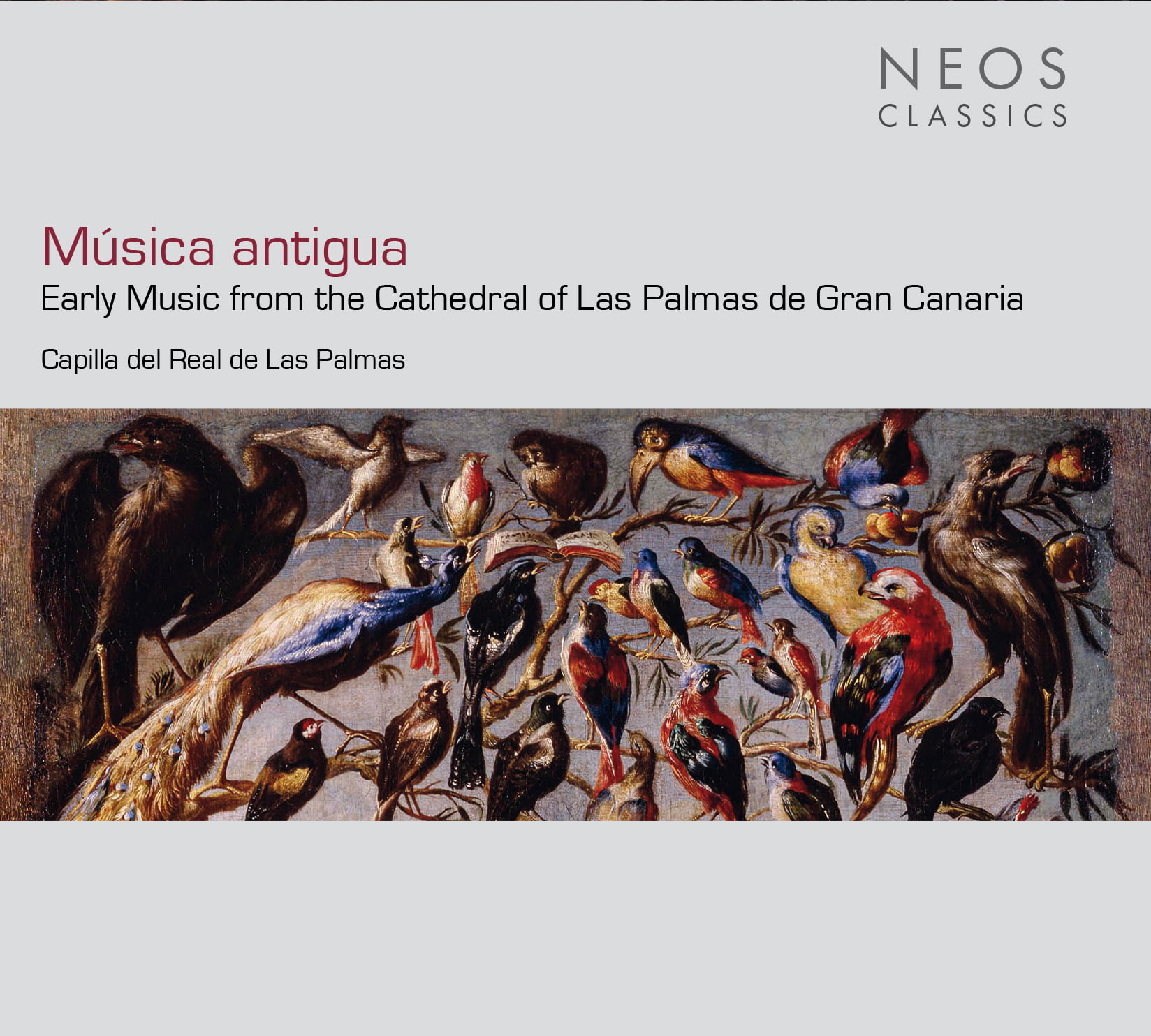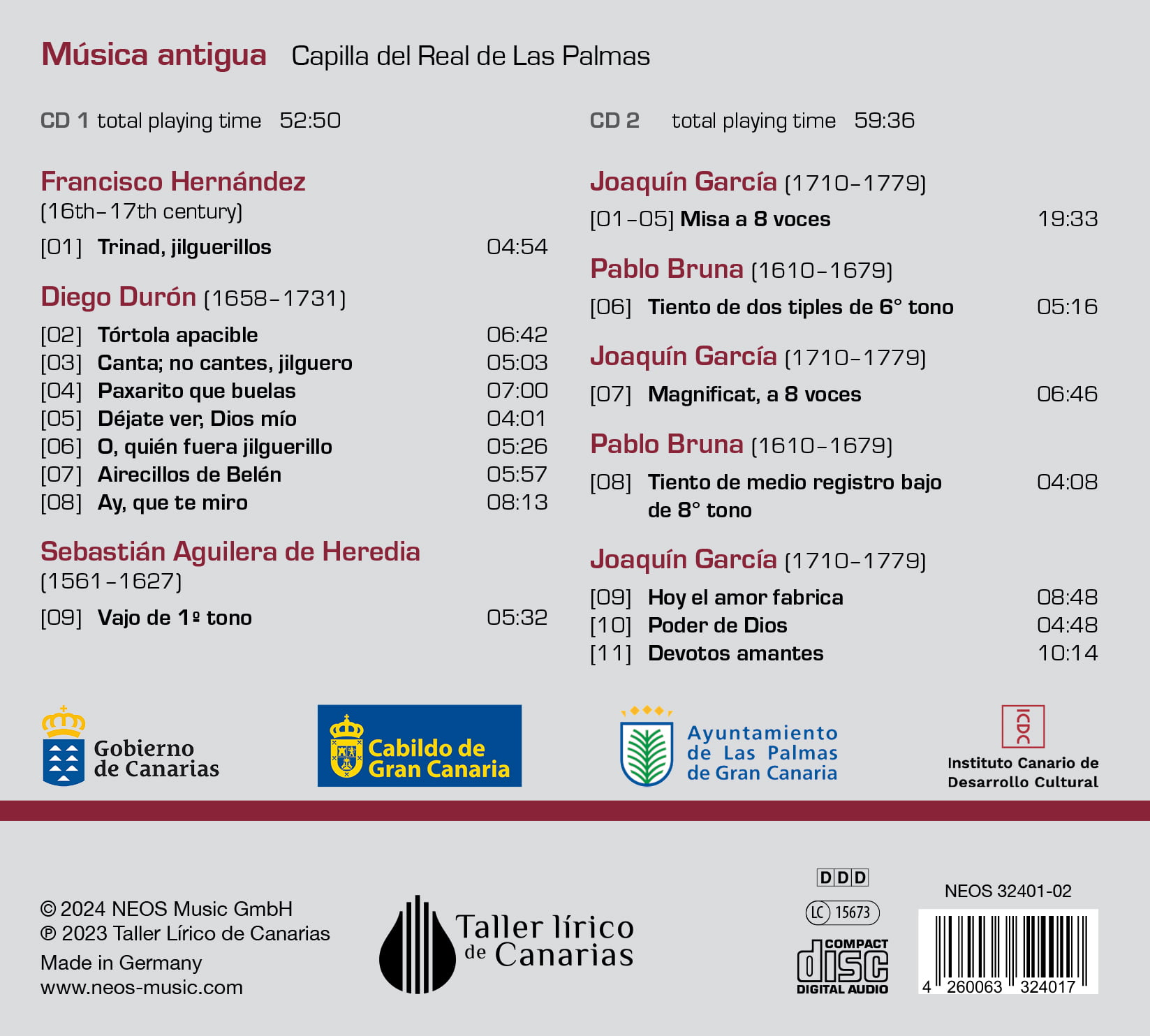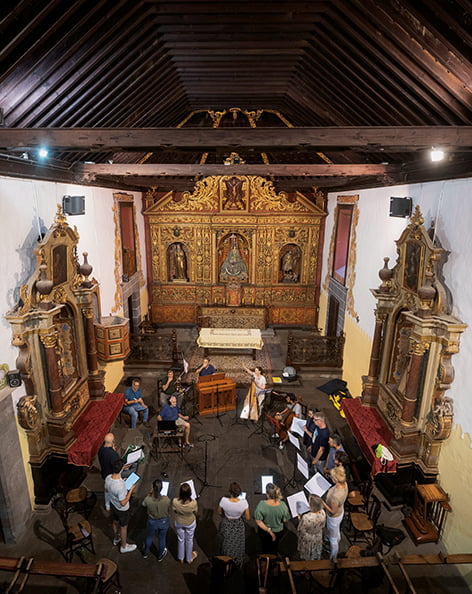MÚSICA ANTIGUA
Early music from the Cathedral of Las Palmas de Gran Canaria
The Cathedral of Las Palmas
Construction of the church began in 1497, ten years after the Catholic Monarchs had expressed their desire to build a cathedral in the city of Las Palmas. There were two major construction phases, the first lasted from 1497 to 1570 and was interrupted due to lack of funds, the second began in 1781 and extended into the 19th century. In 1894 the church was opened by Pope Leo XIII. named Basilica of the Canary Islands. Due to its long construction history, the cathedral has such different architectural styles as late Gothic in the interior (from the time construction began) and neoclassicism (from the time of completion at the beginning of the 19th century) in the exterior. The facade is the most characteristic element of the building and served as a prototype for what years later became the building model for the Plazas de Armas of various New Spanish cities on the American continent.
The cathedral music archive
From the beginning, the cathedral had its own music band. The various bandmasters who performed their duties here compiled a catalog of works from which today's music archive of the Cathedral of the Canary Islands emerged. The oldest books that have survived date from 1514. Maestro Juan Ruiz from Seville took over all duties in 1518: he was organist, cantor and led the choir. No recorded compositions exist by this master and his successors until the end of the century, as these, as well as the organ pipes and bells, were lost in the attack of the Dutch army under Admiral Van der Does in 1599. During the first three years of the 17th century, the population was struck by an epidemic, to which the bandmaster Francisco de la Cruz also fell victim.
The Villancico
The beginnings of the genre Carol are dated by some musicologists to the beginning of the 11th century; the Carol is considered a traditional poetic form that goes back to the Mozarabic songs of that century. Originally were Christmas carols of a folk nature - songs written by the common people villains (farmers, villagers), were composed and sung and had current events as their theme. They achieved their greatest popularity between the 15th and 18th centuries when they devoted themselves to religious themes related to Christmas. Included in the Baroque period Christmas carols the fields of poetry, music and dance and spread throughout the Iberian Peninsula. They made reference to other folk traditions such as those of the Galicians, Catalans, Basques and Portuguese and included texts in their languages. The Carol also crossed the Atlantic and merged with the folk dances of other cultures, the so-called Bailes de negros, like that banana and the Panama. From the original ones jácaras came about corridos, who used the typical language of the slaves and African music and as Bold were designated. On the Canary Islands he experienced Carol its heyday from the end of the 16th to the end of the 18th century. The cathedral's bandmasters, Francisco Hernández, Diego Durón and Joaquín García, composed the works on this recording over the course of almost two centuries.
Francisco Hernández (16th–17th centuries)
Very little is known about him. He worked as a tenor singer and composer at the Santa Ana Cathedral in Las Palmas de Gran Canaria after it proved difficult to find a bandmaster willing to travel to the Canary Islands.
Diego Duron (1658-1731)
He studied music in Seville with the Kapellmeister of the Cathedral of Cuenca. At the age of 18 he traveled to Las Palmas de Gran Canaria, where he took over the leadership of the band of the Cathedral of Santa Ana and held this office for 55 years, until his death in 1731. He was a very prolific composer, probably Wrote around 500 works, in particular Christmas carols on a variety of topics. Like other Baroque composers, he composed numerous dance pieces in which the characters in the Christmas story of Bethlehem took on the character and manner of speaking of Africans, Portuguese, Galicians and Valencians.
Joaquín García (1710-1779)
He studied music in his home country. His compositions show a clear Italian influence and are written in the form of recitatives and arias. At the age of 24, he made his way to Las Palmas de Gran Canaria to succeed Maestro Diego Durón. In 1735 he was employed as bandmaster of the Santa Ana Cathedral. García modernized the musical style by using various instruments that had not been used on the island until then. As a legacy to the cathedral's band, he created 44 works in his 569 years of activity.
Music for keyboard instruments in the 17th century
After music for keyboard instruments had already experienced extensive development in the 16th century, in the 17th century the Crown of Aragon produced great composers who wrote music for the organs of their bands. They occupied a privileged position and had excellent performers (including Pablo Bruna and Sebastián Aguilera de Heredia) and magnificent instruments.
Sebastian Aguilera de Heredia (1561-1627)
He was the most important representative of the Aragonese organ school. He was born in Zaragoza and was organist at the Cathedral of Huesca from 1585 to 1603, after which he returned to Zaragoza to the Cathedral of La Seo. He composed 19 major organ works as well as a collection of four-, five-, six- and eight-part organ works Magnificats, which are frequently performed in Spanish cathedrals.
Pablo Bruna (1611-1679)
He was born in Daroca (Aragon, Spain) and was bandmaster of the Capilla de la Colegiata for 48 years until his death. He had been blind since the age of 5 and yet became one of the most important organists and composers of his time. He received various offers to lead the most important music bands, but he rejected all of them. He stayed in Daroca, where thousands of people - including Kings Felipe IV and Carlos II - made pilgrimages to hear his music and playing.
The Capilla del Real de Las Palmas was founded in 2009 by Carlos Oramas, Isabel Álvarez and Vicent Bru in Las Palmas de Gran Canaria. The ensemble specializes in the rediscovery, transcription and performance of religious music composed by the bandmasters of Las Palmas Cathedral and which is located in the cathedral's music archive. Over the years the ensemble has performed several concerts of unpublished programs and Christmas carols the composers Diego Durón (1658–1731) and Joaquín García (1710–1779). The members of the ensemble have extensive experience in the field of early music and have already worked with first-class ensembles such as La Capella Reial de Catalunya, Hesperion XX, Capilla Peñaflorida, Al Ayre Español, Accentus Austria, El Concierto Español, Ensemble Elyma, Capela Compostelana, La Colombina , Camerata Ibérica, Europa Galante or La Chimera. They performed under the direction of renowned specialists, including: Jordi Savall, Eduardo López Banzo, Fabio Bonizzoni, Claudio Astronio, Kees Boeke, Gabriel Garrido, Eduardo Egüez and Fabio Biondi, to name just a few.


